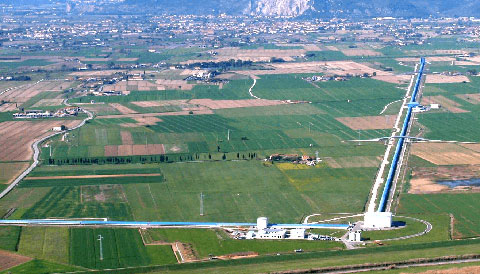
Pulsar Limits “Fifth Force” Interactions with Dark Matter
A recent experiment to better understand the nature of dark matter constrains a possible "fifth force" of nature to almost zero.

Too Many Massive Stars in Universe's Youngest Galaxies
A new method of measuring star formation in the earliest galaxies finds that they’re producing more massive stars than expected — a result that could affect our understanding of how galaxies grow their stars.

Early Star Formation Presents New Cosmic Mystery
New observations suggest that stars were forming just 250 million years after the Big Bang — a record-breaker that will likely open a new line of cosmological inquiry.

Hawking Takes on the Infinite Multiverse
Stephen Hawking’s last paper on cosmology, published posthumously, might solve the problem of eternal inflation, a theory that suggests our cosmos is but one in a sea of infinite universes.

Primordial Chill Hints at Dark Matter Interactions in Early Universe
A simple experiment has detected a signal from the first stars forming just 180 million years after the Big Bang. The observations have intriguing implications for the nature of dark matter.

Simulating the Universe: The Next Generation
A new suite of cosmological simulations sheds light on the interconnected cosmic processes that shape the universe.

Dark Energy Survey Releases First Three Years of Data
Results from the first data release of the Dark Energy Survey include eleven new stellar streams in the Milky Way galaxy.

Stars Map Dark Matter in Dwarf Galaxy
A combo of Hubble and Gaia data reveal the distribution of dark matter in a tiny galaxy by tracking the galaxy’s stars.

The Black Hole Files with Camille Carlisle
Most Distant Black Hole Yet
Astronomers have discovered a supermassive black hole scarfing down gas just 690 million years after the Big Bang.

The Black Hole Files with Camille Carlisle
LIGO Sees Smallest Black Hole Binary Yet
LIGO has detected another black hole merger, raising the tally to five.

Astronomers Catch Gravitational Waves from Colliding Neutron Stars
Spacetime ripples from the neutron star smash-up usher in the age of multi-messenger astronomy.

2017 Nobel Goes to Gravitational Waves
Three American physicists have received the Nobel Prize in physics for their contributions to the discovery of gravitational waves.

Fourth Gravitational Wave Event Detected
Teaming up with LIGO, Europe’s Virgo detector has bagged its first gravitational waves. The three-observatory detection enabled scientists to better pinpoint the merging black holes’ location.

Some Cosmic Rays Come from Outside the Galaxy
Astronomers have detected more extremely energetic cosmic particles coming from one side of the sky than the other.

Featured Image: The Cosmic Velocity Web
Have you ever considered the idea of a cosmic velocity web? Learn more about these intriguing visualizations from the study led by Daniel Pomarède.

Does Dark Energy Change Over Time?
Scientists are considering whether the mysterious “force” accelerating the universe’s expansion changes with time.

Does the Milky Way Live in a Void?
A sparse galactic neighborhood could clear up certain problems with our understanding of the universe.

The Origin of the Milky Way's Mysterious Gamma Rays
Our galaxy's center region is producing gamma rays, but astronomers are still debating whether pulsars or dark matter are the source. Three recent studies tackle the debate head-on.

Debate on Universe’s Cold Spot Heats Up
A new galaxy survey suggests that a supervoid isn’t responsible for the Cold Spot seen in the cosmic microwave background — the oddity may have a far more ancient origin.

Cosmic Lens Provides Unique View of Supernova
Astronomers have discovered a gravitationally lensed Type Ia supernova that will soon give them a new measure of the universe’s expansion.
